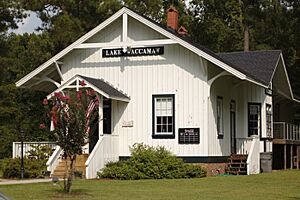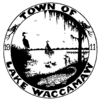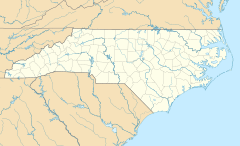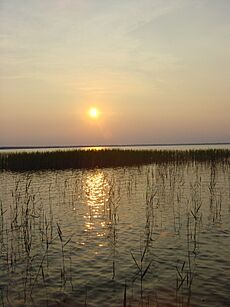Lake Waccamaw, North Carolina facts for kids
Quick facts for kids
Lake Waccamaw, North Carolina
|
||
|---|---|---|

Lake Waccamaw Depot Museum
|
||
|
||
| Country | United States | |
| State | North Carolina | |
| County | Columbus | |
| Area | ||
| • Total | 2.78 sq mi (7.20 km2) | |
| • Land | 2.78 sq mi (7.20 km2) | |
| • Water | 0.00 sq mi (0.00 km2) | |
| Elevation | 56 ft (17 m) | |
| Population
(2020)
|
||
| • Total | 1,296 | |
| • Density | 466.19/sq mi (179.98/km2) | |
| Time zone | UTC-5 (Eastern (EST)) | |
| • Summer (DST) | UTC-4 (EDT) | |
| ZIP code |
28450
|
|
| Area codes | 910, 472 | |
| FIPS code | 37-36640 | |
| GNIS feature ID | 2405979 | |
Lake Waccamaw is a small town in Columbus County, North Carolina, United States. In 2020, about 1,296 people lived there. Long ago, Native Americans called this area home. Later, in the 1700s, Europeans settled here. They started businesses making things for ships, like turpentine oil. This led to the building of the Wilmington-Manchester railroad. A company that made roof shingles later became a lumber company. In 1910, some townspeople started a group called the Waccamaw Club.
The town is named after Lake Waccamaw, a large freshwater lake. This lake is about 9,000 acres and is full of different kinds of plants and animals. It brings a lot of money to the town through tourism. Many unique species of fish, birds, and other creatures live only in this lake. In 2018, a rule that stopped hunting alligators for 40 years was lifted. Lake Waccamaw offers fun activities like birdwatching and hiking because of its many animals and gentle landscape.
Contents
History of Lake Waccamaw Town
The area around Lake Waccamaw was first home to Native Americans. In the 1700s, Europeans began to settle here. King Charles II of England gave special grants to people. These grants allowed them to travel to the new world. They were to bring back riches and news to the king.
By the mid-1700s, Lake Waccamaw had many settlers. People like John Powell, who came from Virginia, brought cattle. His son, Absalom Powell, started buying land near the lake. Another son, Isaac Powell, became an important leader. He was the first major of the local militia in 1804. He also became a justice of peace in 1806. Isaac Powell owned most of the land in Lake Waccamaw.
The town grew slowly with the help of the Wilmington-Manchester railroad. This railroad connected the small town to the rest of the world. The discovery of the freshwater lake also helped the settlement grow. But the biggest growth happened when businesses making naval supplies and turpentine became popular.
In 1869, Charles Oscar Beers started a shingle company. It was located along the southern shore of Lake Waccamaw. Henry Bascom Short also started a company nearby. These two companies later joined together to form Short and Beers. This new company brought more business and jobs to the town. Over time, the company stopped making shingles. It became the North Carolina Lumber Company.
Around 1910, a local group started the Waccamaw Club. This club was a place for hunting parties and social gatherings. The club later closed down. Its building then became the Waccamaw Hotel. The Lake Waccamaw Depot is an important historical building. It was added to the National Register of Historic Places in 1983.
The Waccamaw Dam was built in 1926. The state built it to stop the lake from shrinking during dry weather. In 2018, a new bridge was finished. This bridge goes over the Waccamaw Dam and is open for everyone to use.
Geography of Lake Waccamaw
The town of Lake Waccamaw is in eastern Columbus County. It sits on the north shore of Lake Waccamaw. The town covers about 2.78 square miles (7.20 square kilometers) of land. Only a very small part, about 0.01 square miles (0.03 square kilometers), is water.
Lake Waccamaw is a large freshwater lake, covering about 9,000 acres. An event called "Take the Lake" happens here every year. It's a free fitness event held on Labor Day weekend. People can walk 15 miles around the lake. They can also paddle 14 miles, bike 12 miles and walk 3 miles, or swim 4 miles across the lake. There are no winners announced. Awards are given just for finishing the event. Organizers started "Take the Lake" because their county was ranked as the least healthy in North Carolina.
Population and People
| Historical population | |||
|---|---|---|---|
| Census | Pop. | %± | |
| 1920 | 237 | — | |
| 1930 | 405 | 70.9% | |
| 1940 | 429 | 5.9% | |
| 1950 | 575 | 34.0% | |
| 1960 | 780 | 35.7% | |
| 1970 | 924 | 18.5% | |
| 1980 | 1,133 | 22.6% | |
| 1990 | 954 | −15.8% | |
| 2000 | 1,411 | 47.9% | |
| 2010 | 1,480 | 4.9% | |
| 2020 | 1,296 | −12.4% | |
| U.S. Decennial Census | |||
What is the population of Lake Waccamaw?
| Race | Number | Percentage |
|---|---|---|
| White (non-Hispanic) | 1,071 | 82.64% |
| Black or African American (non-Hispanic) | 119 | 9.18% |
| Native American | 43 | 3.32% |
| Asian | 10 | 0.77% |
| Other/Mixed | 38 | 2.93% |
| Hispanic or Latino | 15 | 1.16% |
According to the 2020 United States census, 1,296 people lived in the town. There were 654 households and 443 families.
Nature and Wildlife
Lake Waccamaw, North Carolina, is home to Lake Waccamaw State Park and a wildlife refuge. Most of the town's money comes from tourism. People enjoy tours around the park and research projects. These projects study the unique species that live only in Lake Waccamaw. Many different animals live in the town because it is right next to the lake. Lake Waccamaw has a high pH and alkalinity. This makes it one of the few lakes that can support endemic species. These are species found only in one specific area.
Animals of Lake Waccamaw
Some land animals that live in Lake Waccamaw State Park include Red-Cockaded Woodpeckers, Swallow-Tailed Kites, and Black Bears. The number of Red-Cockaded Woodpeckers has decreased. This is due to logging and the aging pine forests near the lake. The Swallow-Tailed Kite population is very large here. It is denser in Lake Waccamaw than anywhere else in North Carolina. Black bears live in the town and the surrounding forests. The forests are perfect for them. They offer places to make dens, find food, and stay safe from the weather. Other birds like Brown-headed nuthatches, parula warblers, and white-eyed vireos also live here.
The water life in Lake Waccamaw is very diverse. Many fish species live here, such as the Waccamaw Darter, the Waccamaw Killfish, and the Waccamaw Silverside. Alligators are also part of the lake's ecosystem. A ban on alligator hunting was lifted in March 2018. This ban had been in place for over 40 years. It was removed because the alligator population had returned to normal levels. Bullfrogs, leopard frogs, and cricket frogs live in the wet areas around the lake. The Waccamaw fatmucket and Waccamaw Spike are types of mollusks. They help filter the water in the lake.
Plants of Lake Waccamaw
Some rare native plants in Lake Waccamaw include the Venus-hair fern, green-fly orchid, seven-angled pipewort, Narrowleaf yellow pond lily, and water arrowhead. In 2012, people living nearby reported a problem. Researchers confirmed that an invasive water weed called hydrilla had spread. It had taken over 600 acres of Lake Waccamaw. There are also two unique snail species found here: the Waccamaw amnicola and the Waccamaw Siltsnail.
Terrain and Environment
The land around the town is also varied. It includes forested wetlands, tidal marshes, and longleaf pine forests. The tidal marshes help clean pollution from the water. In the 1700s and 1800s, these marshes were used for growing rice. The longleaf pine forests are home to birds, bears, deer, and other animals. Prescribed burning is used to manage the growth of the forest. Forested wetlands are very important. They help reduce flooding and provide shelter for many creatures. They also offer feeding opportunities when water levels rise.
About Lake Waccamaw (the Lake)
Lake Waccamaw is North Carolina's largest natural freshwater lake. It is also the biggest of the North Carolina Bay Lakes, covering 8,938 acres. It's called a Bay Lake not because it's a bay, but because of the many Sweet Bay and Red Bay trees growing along its shores. The lake is about 5.2 miles long and 3.5 miles wide. Scientists believe it is between 10,000 and 15,000 years old. Many other bodies of water flow into Lake Waccamaw. These include the Waccamaw River and four smaller creeks. The largest of these creeks is called Big Creek.
Lake Waccamaw has a very high pH level. This is because of many calcium-rich rock formations under the lake. These formations have slowly dissolved into the water over time. These formations have also created steep cliffs on the north shore of the lake. The calcium mixture is deposited there. While these formations are found under most North Carolina lakes, Lake Waccamaw is the only Bay Lake with them.
Lake Waccamaw offers many fun activities for visitors. You can camp, fish, hunt, go boating, or have a picnic. There are seven miles of trails to explore. You can also find fifty-two different kinds of fish. One popular spot for fishing and visiting is the Bohemian Girl Scenic Bridge. It is named after John A. McNeil, a well-known citizen. This bridge completes a 14-mile path around the lake. It has many fishing platforms and great views of the lake.
Concerns About the Lake
Scientists are concerned about possible pollution in Lake Waccamaw. The lake's water meets the health and legal limits set by the Safe Drinking Water Act. However, there is a high level of chloroform in the lake. It measures 4.43 parts per billion (ppb), while the allowed limit is 14 ppb. Chloroform is a chemical often used to treat wheat products, as a coolant, and to remove stains. Chloroform can occur naturally, but its presence in water is usually caused by human activity. The lake itself is natural. It is part of the Bladen Lake group, which formed when ocean waters pulled back long ago.
Schools and Education
East Columbus High School is located in Lake Waccamaw. It opened in 1992. Students from Lake Waccamaw, Riegelwood, Delco, and Hallsboro attend this school. It includes students from Acme-Delco and Hallsboro Middle Schools. The school has 449 students. There are 14 students for every teacher. East Columbus High School has an 85 percent graduation rate. The school's mascot is the Gator. Professional basketball player Boubacar Aw went to East Columbus for his senior year.
Lake Waccamaw also has a charter school called Flemington Academy. This academy works with the Boys and Girls Homes of North Carolina. Flemington Academy has 83 students. There are about 6 to 11 students for every teacher. It serves grades 6 through 12. Its graduation rate is 79 percent. The Boys and Girls Homes of North Carolina is the only private boarding school in the county. It aims to provide a good education for students aged 6 to 21. These students may have experienced difficult situations. Lake Waccamaw does not have elementary schools. However, Columbus County has elementary schools in Hallsboro, which is nearby. The closest college to Lake Waccamaw is Southeastern Community College. It is only 15 miles away.
Waccamaw Siouan Tribe
The Waccamaw Sioux or Waccamaw Siouan are one of eight Native American tribes. They are officially recognized by the North Carolina government. The Waccamaw Siouan Indians are different from other Waccamaw groups. They are not connected to the Waccamaw People of North Carolina. They are also separate from the Waccamaw Siouan of Farmers Union, South Carolina. The Lake Waccamaw Indians are known as the "People of the Falling Star." This name comes from a huge meteorite that crashed to Earth long ago. It created the crater that is now Lake Waccamaw. The Waccamaw Siouan live near the Green Swamp. They reside in a protected swampland area. The Waccamaw Indians were first called the Waccon and then the Waccammassus Indians. White settlers changed their name to Waccamaw. This was because it was easier for English settlers to say.
See also
 In Spanish: Lake Waccamaw (Carolina del Norte) para niños
In Spanish: Lake Waccamaw (Carolina del Norte) para niños




